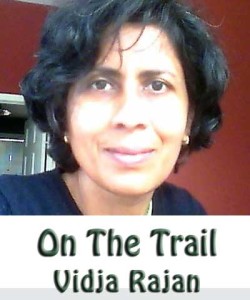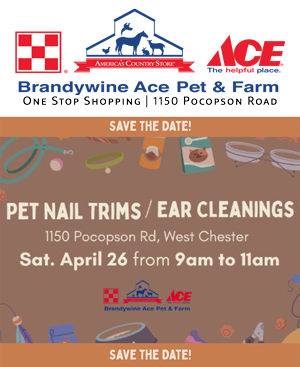 Round trip distance: About 2 miles
Round trip distance: About 2 miles
Difficulty: Easy
Website: http://www.london-grove.pa.us/index.asp?Type=B_BASIC&SEC=%7B8E08CC3F-1E43-412F-836C-223E1F993BD9%7D
Trail Map: https://maps.google.com/maps?hl=en&tab=ml
Trail Photos: https://picasaweb.google.com/111242976600600025974/GoddardPark
Goddard Park came into being earlier this year. I have been walking in this area regularly for a couple of years; in past years I was one of very few users, and the trails were rough. The changes came in the spring of 2012, and now this park boasts gravel trails, a spectacular wooden children’s playground, and a fenced-in dog park. The park has been created sensitively, using pre-existing trails and leaving particularly lovely tree specimens alone. The success of the park is attested to by the increased usage. On the map, the suggested 2 mile trail is shown in blue, and alternate short trails in red. The nice thing about this park is that the trails interconnect and once you are familiar with the layout, you can wander about at will without fear of getting lost (which happened to me years ago, before this park was developed.) Follow all posted rules. Bring your own doggie poop bags.
Park your car in the main parking lot off Route 841, just beyond the State Street intersection. An attractive children’s playground is to the north, and a fenced dog park is to the south, of the parking lot. Walk towards the western end of the parking lot and turn left (north) heading past the dog park. The gravel trail loops around to the right, into the woods. A short, steep trail leads down across the woods to the field on the other side.
Bear left on the path which parallels the road to the far end of the field. If you dislike the road, or prefer to be farther from it, turn right and walk across the field on the other side, ignoring the side trails and looping around to the left to meet up with the trail beside the road. At the top of the field, the trail passes through the tree line to loop around yet another field. Straight ahead is a large autumn olive plant, grown to tree-like proportions.
In the spring, little white flowers cover the plant, giving off a gorgeous scent. Following around to the left on the path, the view opens over the large field fringed by trees. Follow the path by the side of the road, which leads into woods again. As the path curves to the right, a marshy stream bed comes into view on the left. In the spring, it is covered in skunk cabbage. The path curves back to the north through the tulip poplar and beech wood. The ground can get a little wet underfoot here, so watch your step. The path emerges on the large field traversed earlier and turns sharply to the left and plunges downhill back into woods on the west.
You will catch glimpses of a development nearby and occasional trails branch off the path towards them. Follow the path ahead to which winds to the right on to the field, and curves left, back into the woods. Here, there are lots of beeches and maples sporting the occasional grapevine, more undergrowth, and mulched paths underfoot. To the left are tree tubes protecting saplings. At the trail marker at the fork, bear left over the bubbling stream, and up the hill.
In early spring, the woods are filled with the ephemeral wildflowers, particularly trout lily and spring beauty. Also present near the streams, and spreading fast, is the invasive, but splendid, Lesser Celandine. Autumn olive and multiflora rose are other invasives that, for all their unpleasantness to the environment, have beautiful flowers and enchanting scents.
The path passes steeply up the hill and then turns right. Walk along the path, with nice views down the valley to the right. The path passes out of the woods and towards the development. Turn right on the well-made gravel path which then turns into a tarmac surface which makes a sharp right turn and heads downhill. At the bottom of the slope is a small pond with benches placed around it for a little rest and relaxation. A very creditable effort has been made to beautify this area, with beds planted with viburnum and arrowroot. When you are ready to leave, a small bridge traverses the stream to take you back to the parking lot.
Nature Notes: Feces
Poop; merde; scat; dung; droppings; stool – call it what you will. It’s a part of life – what goes in must come out – but for obvious reasons, this fascinating topic is little discussed in polite company. I intend to um, rectify – get it? – this omission.
All living organisms produce waste products of metabolism such as oxygen (from photosynthesis) and carbon dioxide (from respiration), but the term “feces” generally refers to the waste emanating from an animal’s digestive tract. From an anthropocentric world view feces is repellent, but anyone with a dog will testify that this feeling is not shared by man’s best friend. In fact, for some animals, notably langomorphs (rabbits and hares) consumption of feces (called coprophagia) is mandatory for good health. There is plenty of good stuff left in feces, especially of herbivores, which supports the lifestyle of rabbits, dung beetles, earthworms and even dogs on occasion. And do not forget that when the dodo went extinct, so did a lot of plants which had relied on passing through its digestive tract to stimulate germination.
You have probably noticed, not to put too fine a point on it, that the texture and odor of feces changes depending on what you’ve eaten. Woe betide you if you have neglected to consume enough fiber, for you will be ensconced upon the “throne” for hours in considerable discomfort. Woe upon others if you have consumed too much fiber in the form of beans, for it will be fermented by bacteria in your colon and vast quantities of methane produced, much like a cow. Recent research has shown that gut microbiota have a significant impact on health, and their composition depends on diet and use of medication such as antibiotics. Researchers have gone so far as to call the bacteria and fungi associated with the body an organ, influencing everything from health to immune function to fat storage (If you would like me to expand on this fascinating subject, let me know in the comments area.)
Finally, feces has negatives as well. The odor of feces is unpleasant, but there is a hypothesis out there which says that food that’s bad for you is perceived as stinky or bad-tasting to minimize its consumption – this is obviously true for food that’s gone off. Feces can transmit diseases and eggs of parasites such as worms. Contamination of streams with feces has a negative impact on water quality and aquatic life. Untreated sewage is obviously a source of contamination, but so is dog feces that is left on hiking trails by pet-owners. Needless to say, this makes hiking unpleasant for people coming after, but it also washes into streams and eventually into the source of the water that you may be getting from your tap.
Do I even need to say it: PLEASE pick up after your pet!
Further reading:
Why you should pick up after your dog








Brilliant article. I would like to visit Goddard Park sometime! The “Nature Notes”were particularly well written and I do hope a lot of readers spend some time on that section.